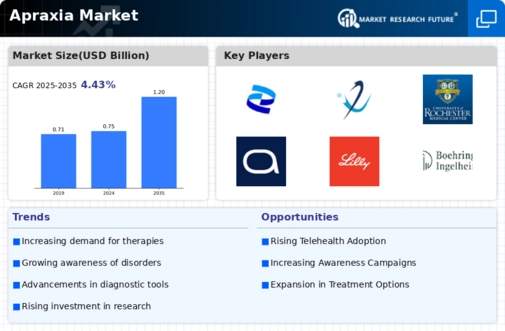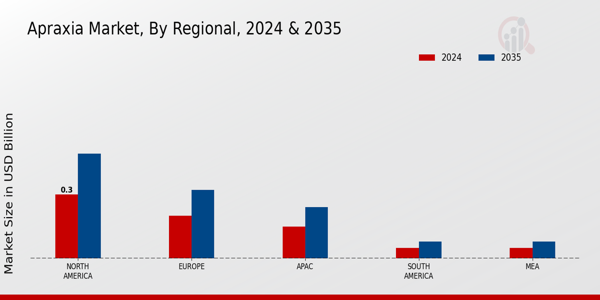Market Growth Projections
The Global Apraxia Market Industry is projected to experience substantial growth over the next decade. With a market value of 0.75 USD Billion in 2024, it is expected to reach 1.2 USD Billion by 2035, reflecting a robust CAGR of 4.37% from 2025 to 2035. This growth trajectory indicates a rising demand for diagnostic and therapeutic solutions for apraxia, driven by factors such as increasing awareness, advancements in treatment options, and demographic changes. The market's expansion is indicative of the growing recognition of apraxia as a significant health concern, necessitating ongoing investment and innovation.
Increasing Awareness of Apraxia
The growing awareness of apraxia among healthcare professionals and the general public is a crucial driver for the Global Apraxia Market Industry. Educational initiatives and campaigns aimed at improving understanding of this neurological disorder are gaining traction. As awareness increases, more individuals are likely to seek diagnosis and treatment, thereby expanding the market. In 2024, the market is projected to reach 0.75 USD Billion, reflecting the impact of these awareness efforts. This heightened recognition is essential for early intervention, which can significantly improve patient outcomes and drive market growth.
Development of Targeted Therapies
The development of targeted therapies for apraxia is emerging as a pivotal factor in the Global Apraxia Market Industry. Pharmaceutical companies are increasingly focusing on creating medications and therapeutic interventions that specifically address the underlying mechanisms of apraxia. These targeted approaches may lead to more effective treatment outcomes and improved quality of life for patients. As research progresses, the introduction of novel therapies is anticipated to stimulate market growth. The potential for these innovations to transform treatment paradigms could significantly influence market dynamics in the coming years.
Government Initiatives and Funding
Government initiatives and funding aimed at supporting research and treatment for neurological disorders, including apraxia, play a vital role in the Global Apraxia Market Industry. Increased funding for research projects and public health campaigns can enhance the understanding and management of apraxia. These initiatives may lead to the development of new treatment modalities and improve access to care for affected individuals. As governments prioritize mental health and neurological conditions, the market is likely to benefit from enhanced resources and support, contributing to its overall growth.
Advancements in Diagnostic Techniques
Technological advancements in diagnostic techniques are significantly influencing the Global Apraxia Market Industry. Enhanced imaging technologies and neuropsychological assessments allow for more accurate and timely diagnoses of apraxia. These innovations facilitate better identification of the disorder, leading to increased treatment rates. As diagnostic capabilities improve, healthcare providers can offer tailored interventions, which may enhance patient recovery. The market is expected to grow as these advancements become more widely adopted, contributing to the projected increase to 1.2 USD Billion by 2035. This trend underscores the importance of ongoing research and development in the field.
Rising Prevalence of Neurological Disorders
The rising prevalence of neurological disorders, including apraxia, is a significant driver for the Global Apraxia Market Industry. As the global population ages, the incidence of conditions that affect motor skills and cognitive functions is increasing. This demographic shift is likely to lead to a higher demand for effective treatment options and rehabilitation services for individuals with apraxia. The market is projected to grow at a CAGR of 4.37% from 2025 to 2035, reflecting the increasing need for specialized care. This trend highlights the urgency for healthcare systems to adapt to the growing patient population.
















